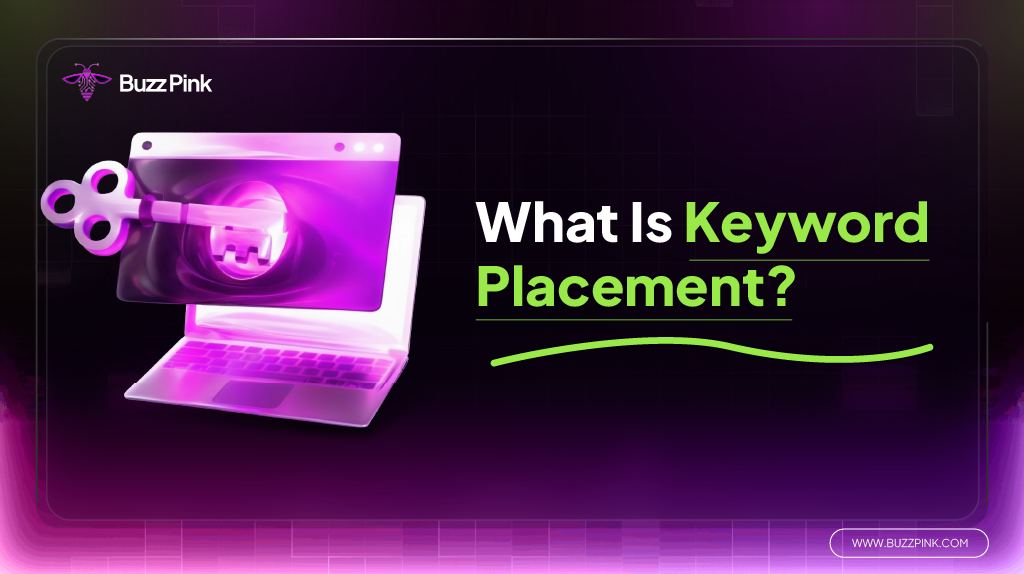Placing keywords in the right places can help search engines understand your content more easily. This is important because Google can’t read content like humans, so it needs keywords as a signal. The more clearly you place your keywords, the more likely your article will appear in search results.
However, keyword placement isn’t just about pleasing Google. It also helps readers feel like your article matches what they’re searching for. So, the benefits are twofold: for search engines and for readers.
What Keyword Placement Means
 Keyword placement isn’t just about repeatedly typing keywords into an article. It’s more about how you place those keywords in strategic places like the title, first paragraph, headings, URL, or description. Placing them in these areas helps Google quickly recognize your content.
Keyword placement isn’t just about repeatedly typing keywords into an article. It’s more about how you place those keywords in strategic places like the title, first paragraph, headings, URL, or description. Placing them in these areas helps Google quickly recognize your content.
For example, if the keyword “how to train your dog” is in the title and description, people searching on Google immediately know that your page covers that topic. Google will also be more confident that your article is relevant to that search. This way, your article can more easily compete for first-page rankings.
Besides being beneficial for search engines, keyword placement is also beneficial for readers. When they see relevant keywords appearing in the title or subheading, they feel confident that the article truly answers their questions. This keeps them engaged throughout the entire article.
Read More: What Is Rank Tracking? A Complete Guide to SEO Keyword Rankings
In conclusion, keyword placement is a smart way to connect your content with both search engines and readers. If done correctly, keyword placement can be key to making your website more popular and useful to more people.
Why Keyword Placement Matters
 Keyword placement is crucial because Google uses keywords to understand the content of a page. If you place keywords strategically, it’s easier for Google to determine whether your content matches what people are searching for. This increases your chances of ranking higher.
Keyword placement is crucial because Google uses keywords to understand the content of a page. If you place keywords strategically, it’s easier for Google to determine whether your content matches what people are searching for. This increases your chances of ranking higher.
Furthermore, keyword placement also impacts the reader’s experience. If keywords appear in the title or description, readers can immediately tell if your page meets their needs. This makes them more likely to click on your page over others.
Increase Search Engine Rankings
Google works by reading keywords found on web pages. If a keyword appears in the title, first paragraph, or headings, it sends a strong signal to Google that your page is relevant to that topic. This increases the chances of your website ranking higher in search results.
The higher your website ranks in search results, the more people will click on it. Most people rarely go beyond the first page of Google. So, if you can get on the first page, your website traffic is likely to increase dramatically.
However, be cautious because using too many or random keywords can be considered spam. Google has an intelligent system that can distinguish between natural content and content that appears forced. If your website is considered spam, its rankings can drop.
This is why keyword placement should be balanced. To remain reader-friendly, include keywords in strategic places while writing naturally.
Enhance User Experience
Besides search engine optimization, keyword placement is also important for readers. When someone searches for something on Google, they want to find answers quickly. If the keyword is in the title or opening paragraph, they immediately believe your article is relevant to their needs.
For example, someone might search for “how to clean white shoes.” If your article title contains that exact keyword, they’ll click more quickly than an article with a vague title. Keyword placement here helps them save time.
When readers find relevant keywords in the subheadings or body of the article, they feel your content truly answers their questions. This encourages them to read longer.
This positive experience also has a positive impact on SEO. The longer people stay on your website, the more Google perceives your page as useful and relevant, increasing your chances of ranking higher.
Read More: How to Integrate SEO and User Experience for Better Website Performance
Serve the Targeted Audience
Good keyword placement can help you target more visitors to your website. This means that visitors aren’t just visiting, but are genuinely interested in the topic or product you’re offering.
For example, if you run an online shoe store and use the keyword “cheap jogging shoes,” visitors to your site are likely looking for jogging shoes. As a result, they are qualified visitors rather than simply curious.
These visitors are more likely to take the desired action, such as reading more, subscribing, or even purchasing a product. So, keyword placement helps generate more valuable traffic.
This way, you’ll not only get a lot of visitors, but also visitors who truly match your target audience. That’s far more valuable than just big numbers without tangible results.
Keyword Placement in SEO
Keyword placement is critical in the SEO industry. SEO aims to make a website appear in Google search results, and keyword placement is one of the most basic yet effective methods for accomplishing this.
SEO, on the other hand, is concerned with the human reader as well as search engines. Keyword placement must be done in a natural way so that Google can understand the content and readers enjoy it.
Webpage Contents
The content of an article or website page is the primary place to place keywords. Google pays close attention to the first 200 words of an article. That’s why keywords should appear at the beginning of the text.
But don’t just do it haphazardly. Keywords should fit in naturally. For example, instead of trying to use the phrase “how to make soft donuts” repeatedly, you could write, “If you want to know how to make soft donuts, this article will explain.” This is more readable.
Besides the beginning, keywords can also appear several times in the middle and end of the article. However, the number of times should be reasonable. If they appear too frequently, Google may consider your article spam.
Essentially, the content of the article is where you balance proper keyword placement with writing that remains comfortable for humans to read.
Meta Descriptions
A meta description is a short text that appears below the title in Google search results. While they don’t directly affect rankings, meta descriptions are important because they can entice people to click on your page.
If keywords appear in the meta description, readers will feel your article is relevant to what they’re searching for. For example, a meta description for an article on “how to make soft donuts” might read: “Find an easy way to make soft donuts with a simple recipe here.”
With a clear meta description, people are more likely to click. The more clicks, the better your website’s reputation in Google’s eyes.
So, always use keywords in your meta description to make your page more attractive and relevant in search results.
Headings
Headings are the main headings (H1) or subheadings (H2, H3) within an article. Google looks at headings to understand the structure and topic of your article.
If keywords are included in headings, Google can more quickly understand what the section is about. For example, the subheading “How to Make Soft Donuts” clearly indicates that the content below it discusses donut recipes.
Besides helping Google, headings with keywords are also beneficial for readers. They can more easily find the section they need without having to read the entire thing.
Therefore, keyword placement in headings can improve SEO while also making the reading experience more enjoyable.
URLs
A URL is the address that appears in browsers and Google search results. A URL containing keywords can help search engines better understand the content of your page.
For example, www.example.com/how-to-make-donuts is better than www.example.com/article123. With keywords in the URL, Google immediately knows the topic is donuts.
Furthermore, URLs with keywords are easier for readers to remember. They can understand the page’s content just by looking at the address.
So, create short, clear URLs that contain your primary keywords for more effective SEO.
Title Tags
The title tag is the title that appears in Google search results and browser tabs. This is one of the most important places to place keywords.
If your keywords appear in the title tag, Google will immediately know what your page is about. For example, “Recipe for Making Soft and Fluffy Donuts” will rank higher in searches for “fluffy donuts.”
Furthermore, the title tag also serves to attract readers’ attention. If the title aligns with the keywords they’re searching for, they’ll be more likely to click on your page.
Therefore, always ensure your primary keyword is in the title tag for better SEO results.
Image Alt Text
Alt text is the text used to describe an image on a web page. Google can’t read images, but it can read alt text to understand the image’s content.
If you include keywords in the alt text, Google will know that the image is relevant to the topic. For example, an image of a donut with the alt text “soft chocolate donut” will be more easily found in Google Images.
Alt text is also useful for readers. If the image doesn’t display, they can still understand the image’s content through this alternative text.
So, don’t forget to include keywords in the alt text to help both SEO and readers.
Things to Consider When Placing Keywords
 Keyword placement is important, but it shouldn’t be done haphazardly. There are several rules to follow to ensure optimal results.
Keyword placement is important, but it shouldn’t be done haphazardly. There are several rules to follow to ensure optimal results.
Too much or incorrect placement can actually be detrimental. Google may consider your content spam, and readers may feel uncomfortable. So, be careful and balanced.
Keyword Stuffing
Keyword stuffing is the mistake of inserting keywords too often in an article. For example, writing “soft donuts” five times in one paragraph. This is unsightly and can damage the quality of your writing.
Google may consider your article spam because it appears to be focused solely on rankings, rather than providing information. As a result, your website’s ranking could drop.
Furthermore, readers will become bored and uncomfortable. They may immediately leave your website because the writing feels forced.
Therefore, use keywords appropriately. Focus on writing naturally to keep your content enjoyable and useful.
Good Readability Score
Besides keywords, writing quality is also important for SEO. Articles should be clear, easy to understand, and concise. If writing is difficult to understand, readers may leave immediately.
Google can detect if people quickly abandon your website. This can lower your SEO value and ranking. Therefore, readability is crucial.
To maintain readability, keep sentences short, use clear paragraphs, and incorporate keywords naturally.
Easy-to-read writing will keep readers engaged, and Google will also rate your content more favorably. Therefore, readability is just as important as keyword placement.
Integrate User Intent and Content
When people search on Google, they have a goal or intent. Some want to learn, others want to buy a product, or others are simply searching for a specific website.
If your content doesn’t align with that intent, readers will be disappointed and leave immediately. Therefore, keyword placement must align with the user’s actual needs.
For example, if the keyword is “buy a cheap laptop,” the content should contain recommendations for laptop stores or products, not just articles on laptop maintenance tips. That’s how intent is met.
By aligning keyword placement with searcher intent, your content will be more relevant and useful, and your website’s ranking will likely improve.
Conclusion
Keyword placement is an important SEO strategy to help Google and readers understand your content. With proper keyword placement, your website can appear higher in search results and attract more visitors.
But remember, keyword placement must be balanced. Don’t just focus on search engines, but also on readers. Readable and useful content is key to your website’s long-term success.
Kamila Putri is a content strategist and digital marketing expert who helps brands craft messages that resonate and drive results. With a strong foundation in SEO, brand voice, and data-driven strategy, she has produced content that performs, whether it's optimized web copy, lead-generating campaigns, or conversion-focused messaging. At Buzz Pink, she applies this expertise to help clients grow through smart, search-focused digital strategies that engage, inform, and convert.


